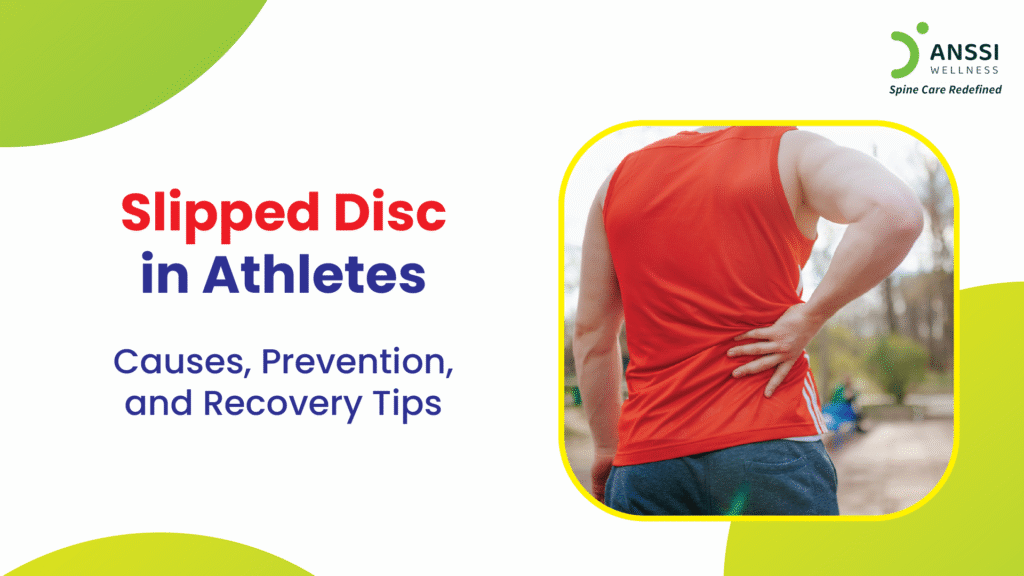Athletes push their bodies to the limit, whether it’s intense training sessions, competitive matches, or high-impact workouts. While this dedication builds strength and skill, it can also put the spine under significant stress. One common spinal injury that affects athletes across sports is the slipped disc, also known as a herniated disc.
Understanding its causes, knowing how to prevent it, and following the right recovery strategies can help athletes protect their performance and avoid long-term complications.
What is a Slipped Disc?
The spine is made up of vertebrae cushioned by soft, gel-like discs that act as shock absorbers. When one of these discs is damaged or its soft inner material pushes out through a crack in the tougher outer layer, it’s called a slipped or herniated disc.
For athletes, this can mean pain, weakness, or numbness that affects their training and competition schedules.
Causes of Slipped Disc in Athletes
A slipped disc occurs due to any of the following reasons.
1. Overtraining and Repetitive Stress
High-intensity training without enough rest can lead to micro-injuries in the spine. Over time, this repeated strain weakens the discs and makes them more prone to herniation.
2. Improper Lifting Techniques
Weightlifting without correct posture, such as bending from the waist instead of the knees, puts uneven pressure on the spine, increasing the risk of disc injury.
3. High-Impact Sports
Sports like football, kabaddi, gymnastics, and wrestling involve sudden twists, pins, and landings that can impact the spine and damage discs.
4. Poor Core Strength
The core muscles act as natural stabilisers for the spine. Weak core strength forces the back to handle more stress, making discs vulnerable during strenuous movements.
Symptoms to Watch For
A slipped disc doesn’t always cause severe symptoms immediately.
Athletes should be alert to:
- Persistent back pain that worsens with movement
- Pain radiating to the legs (sciatica) or arms, depending on the disc’s location
- Numbness, tingling, or muscle weakness
- Reduced flexibility or difficulty bending/straightening the back.
Early attention to these symptoms is essential to prevent worsening of the injury.
Prevention Strategies for Athletes
Preventing a slipped disc requires consistent care for spinal health, even during peak training periods.
- Strengthen the Core: Incorporate exercises like planks, bridges, and abdominal crunches to build muscles that stabilise the spine.
- Master Proper Lifting Techniques: Always bend the knees, keep the back straight, and hold the weight close to the body.
- Improve Flexibility: Stretch the hamstrings, hips, and lower back regularly to reduce stiffness and uneven strain.
- Balance Training and Rest: Overtraining increases injury risk; ensure adequate recovery days and quality sleep.
- Use Correct Equipment: Supportive footwear and proper sports gear help reduce shock and impact on the spine.
Recovery Tips for Slipped Disc in Athletes
When a slipped disc occurs, the priority is healing the injury without rushing back into intense activity.
1. Rest and Gradual Return
Avoid activities that worsen pain, but maintain light movements to prevent stiffness. Gradually reintroduce training under professional supervision.
2. Physiotherapy and Targeted Exercises
A physiotherapist can guide athletes through exercises that restore flexibility, strengthen supporting muscles, and relieve nerve pressure.
3. Non-Surgical Treatments
Non-Surgical Spinal Decompression Treatment is a highly effective, non-invasive option. Using USA-based technology, it gently stretches the spine, reduces disc pressure, and promotes natural healing, without surgery, injections, or medications.
4. Avoid Early Return to Play
Rushing back to sports before the disc has fully healed can cause re-injury and longer downtime. Athletes should get medical clearance before resuming competitive activity.
Long-Term Spinal Health for Athletes
Preventing future disc injuries requires ongoing commitment to spine-friendly habits:
- Maintain strong core muscles year-round.
- Warm up before training and cool down after.
- Monitor training loads to avoid excessive strain.
- Seek regular check-ups with a spine specialist for early detection of issues.
About ANSSI:
ANSSI Wellness focuses on improving the quality of life for patients suffering from spinal issues, aiming to provide relief where other conventional treatments have failed. Through advanced non-surgical spinal decompression treatment, ANSSI is committed to helping patients avoid surgery and recover in a safe, effective, and compassionate environment.
Connect with ANSSI Wellness on LinkedIn, Instagram, and Facebook for expert guidance.




